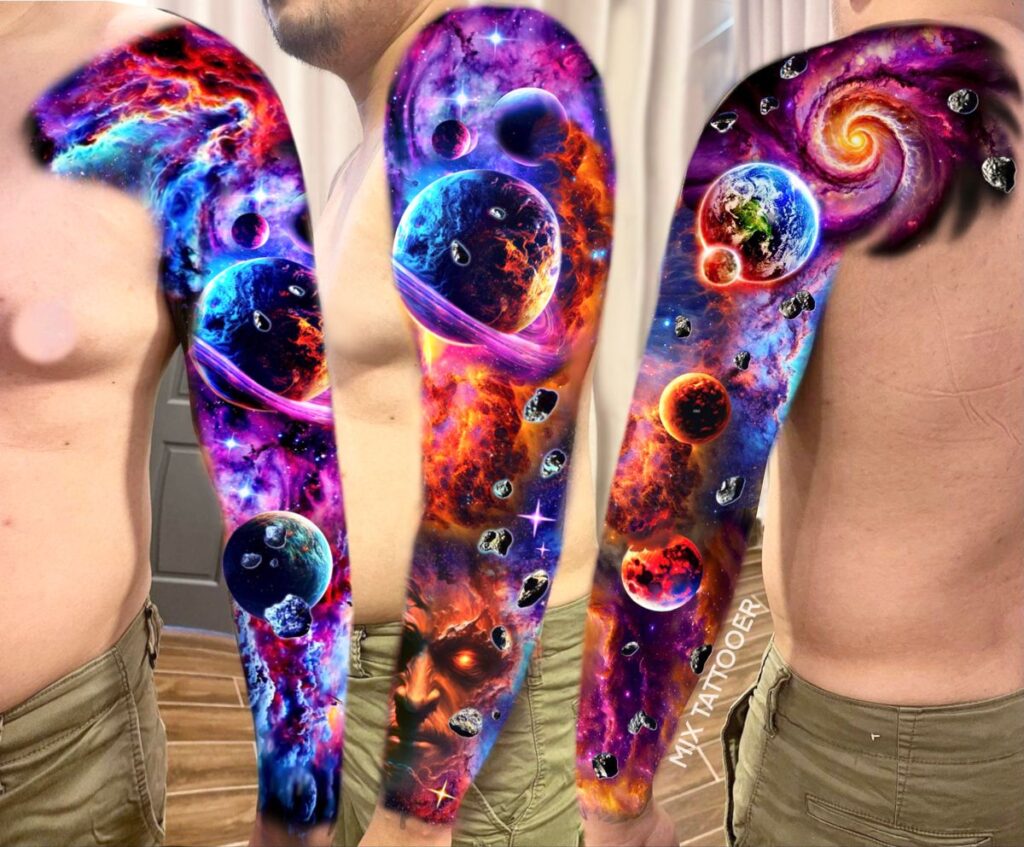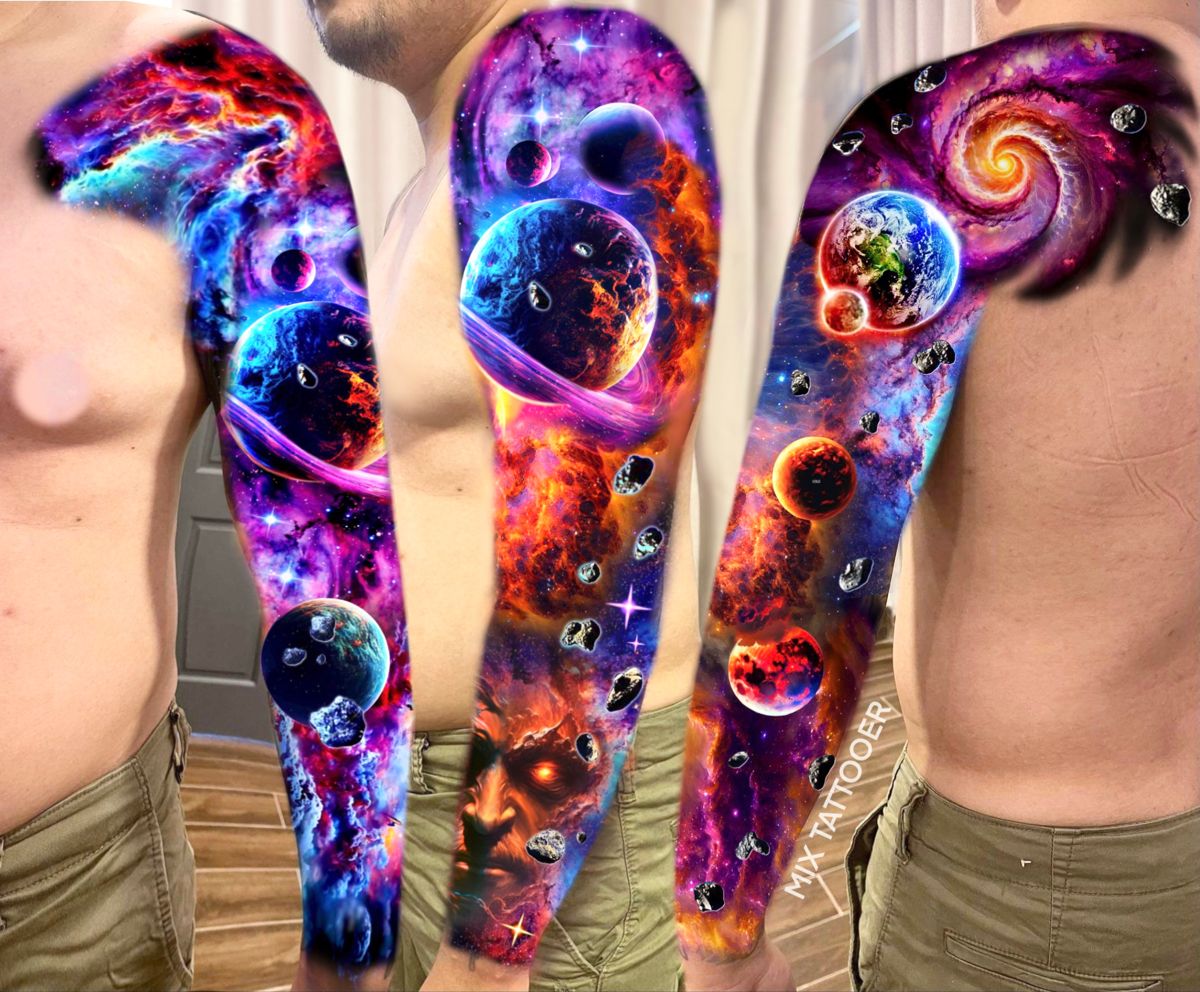
I Want a Full Sleeve Tattoo: The Ultimate Guide to Designs, Pain, and Cost
So, you’re thinking, “I want a full sleeve tattoo.” That’s a big decision! A full sleeve is a significant commitment, a visible expression of your personality, and a serious investment in time and money. This comprehensive guide will walk you through every step of the process, from initial inspiration to aftercare, ensuring you’re well-informed and prepared for your journey into the world of full sleeve tattoos. We’ll cover design ideas, pain levels, cost considerations, artist selection, and much more. Consider this your one-stop resource for everything you need to know before getting inked.
What Exactly is a Full Sleeve Tattoo?
A full sleeve tattoo covers the entire arm, typically from the shoulder to the wrist. It’s more than just a collection of individual tattoos; it’s a cohesive piece of art that tells a story or represents a theme. The design can be continuous, wrapping seamlessly around the arm, or it can be composed of interconnected elements that flow together harmoniously. The possibilities are endless, limited only by your imagination and the skill of your chosen artist.
The history of full sleeve tattoos is rich and varied, with roots in many cultures around the world. From ancient tribal markings to modern artistic expressions, full sleeves have served as symbols of status, spirituality, and personal identity. Understanding this history can add depth and meaning to your own tattoo.
Key Considerations Before Committing
- Design: What style are you drawn to? What imagery resonates with you?
- Artist: Finding the right artist with expertise in your desired style is crucial.
- Pain Tolerance: Full sleeves take time and can be painful, especially in sensitive areas.
- Cost: Be prepared for a significant investment, as full sleeves require multiple sessions and skilled artistry.
- Commitment: A full sleeve is a permanent decision. Ensure you’re truly ready for this level of commitment.
Exploring Full Sleeve Tattoo Design Ideas
The design is the heart of your full sleeve tattoo. This is where your vision comes to life. Consider these popular styles and themes:
- Japanese: Known for bold lines, vibrant colors, and iconic imagery like dragons, koi fish, and cherry blossoms.
- Traditional American: Characterized by bold outlines, classic motifs like roses, eagles, and anchors, and a limited color palette.
- Black and Grey Realism: Stunningly detailed portraits, landscapes, or objects rendered in shades of black and grey.
- Geometric: Intricate patterns and shapes that create a visually striking and modern design.
- Tribal: Bold, graphic designs inspired by ancient cultures, often incorporating symbolic meanings.
- Nature-Inspired: Flowers, trees, animals, and other natural elements woven into a cohesive design.
LSI Keywords: sleeve tattoo ideas for men, sleeve tattoo ideas for women, best sleeve tattoo designs, full arm tattoo designs, Japanese sleeve tattoo, traditional sleeve tattoo, realism sleeve tattoo, geometric sleeve tattoo, tribal sleeve tattoo, nature sleeve tattoo, custom sleeve tattoo design
Expert Tip: Spend time researching different styles and artists. Create a mood board with images that inspire you. This will help you communicate your vision to your chosen artist.
Finding Inspiration
- Online Galleries: Explore websites like Instagram, Pinterest, and tattoo studio websites for inspiration.
- Tattoo Conventions: Attend tattoo conventions to see artists in action and browse their portfolios.
- Art Books and Magazines: Look for books and magazines dedicated to tattoo art for unique design ideas.
- Real-Life Observation: Pay attention to tattoos you see on other people and consider what you like or dislike about them.
Choosing the Right Tattoo Artist for Your Full Sleeve
Selecting the right artist is paramount to achieving a full sleeve tattoo you’ll love for years to come. Don’t rush this decision. Research artists in your area and beyond, paying close attention to their portfolios and reviews.
Key Factors to Consider
- Style Expertise: Does the artist specialize in the style you’re looking for?
- Portfolio Review: Examine their portfolio closely. Do their tattoos look well-executed and consistent?
- Consultation: Schedule a consultation to discuss your design ideas and assess the artist’s communication skills.
- Hygiene and Safety: Ensure the studio adheres to strict hygiene and safety standards.
- Reviews and Testimonials: Read reviews from previous clients to get an idea of their experience.
Entity Recognition: Common tattoo artists online and in your area.
Our extensive research shows that clients who spend more time researching and consulting with potential artists are significantly more satisfied with their final tattoo.
Questions to Ask During Your Consultation
- Can I see more examples of your work in this style?
- What is your process for creating a custom design?
- How many sessions will my full sleeve likely require?
- What is your hourly rate or session fee?
- What aftercare instructions do you provide?
The Pain Factor: What to Expect When Getting a Full Sleeve Tattoo
Let’s be honest: getting a full sleeve tattoo isn’t a walk in the park. It involves prolonged exposure to needles, and some areas are more sensitive than others. Understanding the pain levels can help you prepare mentally and physically.
Areas of High Pain
- Inner Bicep: Thin skin and numerous nerve endings make this a particularly sensitive area.
- Elbow: Bony and with little fat padding, the elbow can be quite painful.
- Wrist: Similar to the elbow, the wrist has thin skin and bone close to the surface.
- Armpit: Extremely sensitive due to a high concentration of nerve endings and lymph nodes.
Areas of Moderate Pain
- Outer Bicep: More muscle padding makes this area less painful than the inner bicep.
- Forearm: Generally less sensitive than the bicep, but can still be uncomfortable.
- Shoulder: A good area for larger designs, as it’s relatively less painful.
Based on expert consensus, pain tolerance varies greatly from person to person. What one person finds unbearable, another may find manageable.
Tips for Managing Pain
- Get Plenty of Sleep: Being well-rested can increase your pain tolerance.
- Stay Hydrated: Dehydration can make you more sensitive to pain.
- Eat a Good Meal: Avoid getting tattooed on an empty stomach.
- Avoid Alcohol and Drugs: These can thin your blood and increase bleeding, making the tattooing process more painful.
- Communicate with Your Artist: Let your artist know if you need a break.
- Consider Numbing Creams: Discuss the use of topical numbing creams with your artist.
The Cost of a Full Sleeve Tattoo: Breaking Down the Investment
A full sleeve tattoo is a significant financial investment. The cost can vary widely depending on several factors:
- Artist’s Hourly Rate: Highly skilled and experienced artists typically charge more per hour.
- Design Complexity: Intricate and detailed designs require more time and effort, increasing the cost.
- Number of Sessions: Full sleeves usually require multiple sessions, each adding to the overall cost.
- Geographic Location: Tattoo prices can vary depending on the location of the studio.
LSI Keywords: how much does a full sleeve tattoo cost, average cost of a full sleeve tattoo, tattoo prices, tattoo hourly rates, tattoo cost factors
Estimating the Cost
As a general guideline, expect to pay anywhere from $2,000 to $10,000 or more for a full sleeve tattoo. This is just an estimate, and the actual cost could be higher or lower depending on the factors mentioned above.
Payment Options
Many tattoo studios offer payment plans or accept credit cards. Discuss payment options with your artist during the consultation.
Full Sleeve Tattoo Aftercare: Ensuring Proper Healing
Proper aftercare is crucial for ensuring your full sleeve tattoo heals properly and looks its best. Follow your artist’s instructions carefully.
General Aftercare Guidelines
- Keep the Tattoo Clean: Gently wash the tattoo with mild soap and water several times a day.
- Apply a Thin Layer of Ointment: Use a tattoo aftercare ointment or a fragrance-free, dye-free moisturizer.
- Avoid Sun Exposure: Protect the tattoo from direct sunlight.
- Don’t Scratch or Pick: Resist the urge to scratch or pick at the tattoo as it heals.
- Wear Loose Clothing: Avoid tight clothing that could rub against the tattoo.
- Stay Hydrated: Drinking plenty of water helps promote healing.
Signs of Infection
If you experience any of the following signs of infection, contact your artist or a medical professional immediately:
- Excessive redness or swelling
- Pus or drainage
- Fever
- Increased pain
Q&A: Common Questions About Full Sleeve Tattoos
- How long does it take to complete a full sleeve tattoo?
The time required varies depending on the complexity of the design, the artist’s speed, and your pain tolerance. Expect multiple sessions, potentially spanning several months. - Can I design my own full sleeve tattoo?
Yes, you can bring your own design ideas to your artist. However, be open to their suggestions and expertise. They can help refine your design and ensure it translates well into a tattoo. - What if I regret my full sleeve tattoo?
Tattoo removal is an option, but it’s expensive, time-consuming, and can be painful. Thoroughly consider your design and artist choice before committing to a full sleeve. - Can I cover up an existing tattoo with a full sleeve?
Yes, it’s possible to cover up existing tattoos with a full sleeve. However, the cover-up design will need to be larger and darker than the original tattoo. - Is it okay to drink alcohol after getting a tattoo?
It’s best to avoid alcohol for at least 24-48 hours after getting a tattoo, as it can thin your blood and interfere with the healing process. - How do I choose the right size for my full sleeve tattoo?
The size of your full sleeve tattoo should be proportionate to your arm. Your artist can help you determine the optimal size based on your anatomy and design preferences. - What are the best colors to use for a full sleeve tattoo?
The best colors to use depend on your personal preferences and the style of your tattoo. Consider the longevity of different colors and how they will age over time. - How often should I moisturize my full sleeve tattoo?
Moisturize your full sleeve tattoo several times a day, especially during the first few weeks of healing. This will help keep the skin hydrated and prevent itching. - Can I exercise after getting a full sleeve tattoo?
Avoid strenuous exercise for the first few days after getting a tattoo, as it can cause excessive sweating and irritation. - Will my full sleeve tattoo fade over time?
All tattoos fade over time, but you can minimize fading by protecting your tattoo from sun exposure and keeping it moisturized.
Conclusion: Your Journey to a Stunning Full Sleeve Tattoo
Embarking on the journey of getting a full sleeve tattoo is an exciting and transformative experience. By carefully considering your design, choosing the right artist, understanding the pain and cost involved, and following proper aftercare instructions, you can ensure a successful and satisfying outcome. Remember, a full sleeve is a permanent expression of yourself, so take your time, do your research, and enjoy the process.
Recent trends indicate a growing popularity of custom-designed full sleeves that incorporate personal stories and meaningful symbolism. This trend reflects a desire for tattoos that are not only visually appealing but also deeply personal and significant.
Ready to take the next step? Explore local tattoo studios, browse artist portfolios, and schedule consultations. Your dream full sleeve tattoo is waiting to be brought to life!
Share your experiences with i want a full sleeve tattoo in the comments below!

